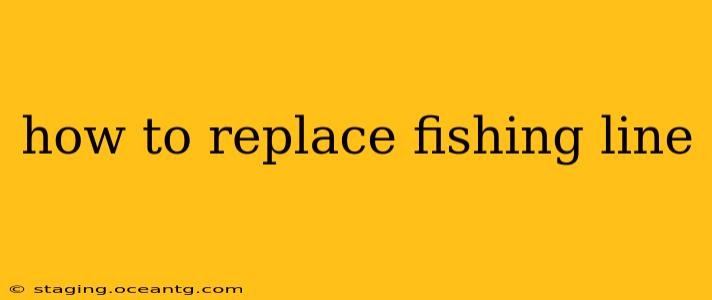Replacing your fishing line is a crucial part of successful fishing. Old, damaged line can lead to lost fish, broken rods, and frustrating fishing trips. This comprehensive guide will walk you through the process, answering common questions and ensuring you're ready for your next angling adventure.
Why Replace Your Fishing Line?
Before diving into the "how-to," let's understand why replacing your fishing line is so important. Over time, fishing line degrades due to exposure to sunlight, saltwater, and abrasion. This degradation weakens the line, making it more prone to breakage. Several factors indicate it's time for a replacement:
- Visible Damage: Scratches, nicks, or fraying are clear signs of wear and tear.
- Loss of Strength: If you experience frequent unexplained line breaks, your line is likely weakened.
- Age: Even without visible damage, line should be replaced regularly. The recommended timeframe depends on the type of line and how frequently you fish, but generally, replacing it once or twice a year is a good rule of thumb.
- Color Change: Significant fading or discoloration indicates UV degradation.
What Tools Do I Need to Replace Fishing Line?
Replacing your fishing line requires minimal tools, but having the right ones makes the process much smoother:
- New Spool of Fishing Line: Choose the correct line diameter and type for your fishing needs.
- Fishing Rod: Obviously!
- Line Stripper (Optional but Recommended): This tool quickly removes old line from your reel. If you don't have one, you can use your fingers, but it's much slower and potentially more damaging to your fingers.
- Scissors or Line Cutters: Sharp scissors or specialized line cutters provide a clean cut.
- Reel Lubricant (Optional): Helps your reel run smoothly.
How to Remove Old Fishing Line from Your Reel
This is the first step, and there are a couple of ways to approach it:
Method 1: Using a Line Stripper
- Attach the line stripper: Securely fasten the line stripper according to its instructions.
- Turn the handle: Slowly crank the handle of your fishing reel, feeding the old line through the stripper. This will quickly remove the line from your spool.
Method 2: Manual Removal
- Find the end: Locate the end of your old fishing line on the spool.
- Pull the line: Gently pull the line off the spool, using your fingers to guide it. This method is time-consuming and can be hard on your fingers.
How to Load New Fishing Line onto Your Reel
Once the old line is removed, it’s time to load the new line:
- Secure the new line: Thread the new line through the guides on your rod and attach it to your reel. Most reels have a small opening or arbor on the spool to help with this.
- Fill the spool: Slowly turn the handle of your reel, ensuring the line is evenly distributed across the spool. Avoid overfilling the spool. Leave some space at the top (usually about 1/8" to ¼") to prevent line from overflowing during casting.
- Tie the knot: Once you're finished filling the spool, cut the line and secure the end with a knot. The most common knot is a simple overhand knot. However, if you're not sure how to tie this knot securely, watch some YouTube videos on line knotting to see what works best for your style of fishing and type of line.
How Often Should I Replace My Fishing Line?
The frequency of replacing your fishing line depends on several factors:
- Type of Line: Monofilament lines typically last longer than braided lines.
- Fishing Conditions: Saltwater environments degrade line faster than freshwater.
- Usage: Frequent fishing requires more frequent line changes.
As a general rule, replacing your line at least once a year, or sooner if you notice any damage, is a good practice.
What Type of Fishing Line Should I Use?
Choosing the right fishing line is crucial for success. Several types are available, each with its advantages and disadvantages:
- Monofilament: Durable, affordable, and relatively easy to use.
- Fluorocarbon: Less visible to fish, strong, and abrasion-resistant.
- Braided Line: Extremely strong, sensitive, and casts well, though it can be more expensive and susceptible to abrasion.
By following these steps and understanding the importance of regular line replacement, you'll ensure your fishing gear is always in top condition and ready for that next big catch. Remember to always check your line before each fishing trip for any signs of damage. Happy fishing!
